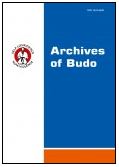2021, Volume 17
Injuries at World and European judo tournaments in 2010-2012
Wiesław Błach1, Nikos Malliaropoulos 2, Łukasz Rydzik3, Georgios Bikos4, Artur Litwiniuk5, Juris Grants6, Tadeusz Ambroży7, Nicola Maffulli8
1Department of Sport, University School of Physical Education in Wroclaw, Wrocław, Poland
2Centre for Sports and Exercise Medicine, Queen Mary University of London, London, United Kingdom
3Institute of Sport Science, University of Physical Education in Krakow, Krakow, Poland
4Euromedica-Arogi Rehabilitation Clinic, Thessaloniki,, Greece
5Faculty of Physical Education and Health, Jozef Pilsudski University of Physical Education in Warsaw, Biała Podlaska, Poland
6Latvian Academy of Sport Education, Riga, Latvia
7Institute of Sport Science, University of Physical Education in Krakow, Kraków, Poland
8Department of Musculoskeletal Disorders, University of Salerno School of Medicine, Salerno, Italy
Author for correspondence: Łukasz Rydzik; Institute of Sport Science, University of Physical Education in Krakow, Krakow, Poland; email: lukasz.gne@op.pl
Full text
Abstract
Background and Study Aim: In Olympic judo, athletes are not allowed to kick, punch, or strike, or use any equipment or weapons. The athlete must subdue the opponent only by gripping the uniform and using techniques to lift and throw the competitor or pin them down to the mat. The purpose of the research is to know about type of injuries judo athletes during the European and World Judo Championships respectively, from 2010 to 2012 and evaluates the differences between men and women.
Material and Methods: The study investigates the incidence and type of injuries of 3408 and 3860 athletes at 16 European and 9 World Judo Championships respectively, from 2010 to 2012 and evaluates the differences between men and women.
Results: Bleeding and excoriation or wounds were the most frequent injuries accounted for 3.82% and 3.96% of total injuries for men and women respectively. There was no statistically significant difference in overall injury incidence between World and European tournaments (6% vs 8%, p = 0.57) and between European cadets, junior and senior tournaments (4% vs 6% vs 6%, p = 0.51 and p = 1.000). The overall injury rate was significantly higher in the veteran tournaments when compared to the other European tournaments (17% vs 4%, p = 0.002; 17% vs 6%, p = 0.01).
Conclusions: The study additionally shows that international judo competitions are associated with a low overall injury incidence. The risk of injury is greater and statistically significant in the veterans judo athletes group. Therefore, it is necessary to modify the regulations in this rival group.
Key words: individual technique, kata, movement, sequence, tokui-waza, randori




